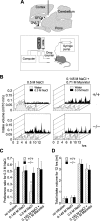The subfornical organ is the primary locus of sodium-level sensing by Na(x) sodium channels for the control of salt-intake behavior
- PMID: 15496663
- PMCID: PMC6730094
- DOI: 10.1523/JNEUROSCI.2795-04.2004
The subfornical organ is the primary locus of sodium-level sensing by Na(x) sodium channels for the control of salt-intake behavior
Abstract
Dehydration causes an increase in the sodium (Na) concentration and osmolarity of body fluid. For Na homeostasis of the body, controls of Na and water intake and excretion are of prime importance. However, the system for sensing the Na level within the brain that is responsible for the control of Na- and water-intake behavior remains to be elucidated. We reported previously that the Na(x) channel is preferentially expressed in the circumventricular organs (CVOs) in the brain and that Na(x) knock-out mice ingest saline in excess under dehydrated conditions. Subsequently, we demonstrated that Na(x) is a Na-level-sensitive Na channel. Here we show that the subfornical organ (SFO) is the principal site for the control of salt-intake behavior, where the Na(x) channel is the Na-level sensor. Infusion of a hypertonic Na solution into the cerebral ventricle induced extensive water intake and aversion to saline in wild-type animals but not in the knock-out mice. Importantly, the aversion to salt was not induced by the infusion of a hyperosmotic mannitol solution with physiological Na concentration in either genotype of mice. When Na(x) cDNA was introduced into the brain of the knock-out mice with an adenoviral expression vector, only animals that received a transduction of the Na(x) gene into the SFO among the CVOs recovered salt-avoiding behavior under dehydrated conditions. These results clearly show that the SFO is the center of the control of salt-intake behavior in the brain, where the Na-level-sensitive Na(x) channel is involved in sensing the physiological increase in the Na level of body fluids.
Figures



Similar articles
-
The subfornical organ, a specialized sodium channel, and the sensing of sodium levels in the brain.Neuroscientist. 2006 Feb;12(1):80-91. doi: 10.1177/1073858405279683. Neuroscientist. 2006. PMID: 16394195 Review.
-
Sodium sensing in the subfornical organ and body-fluid homeostasis.Neurosci Res. 2016 Dec;113:1-11. doi: 10.1016/j.neures.2016.07.007. Epub 2016 Aug 10. Neurosci Res. 2016. PMID: 27521454 Review.
-
Hydromineral neuroendocrinology: mechanism of sensing sodium levels in the mammalian brain.Exp Physiol. 2007 May;92(3):513-22. doi: 10.1113/expphysiol.2006.035659. Epub 2007 Mar 9. Exp Physiol. 2007. PMID: 17350991 Review.
-
Endothelin-3 expression in the subfornical organ enhances the sensitivity of Na(x), the brain sodium-level sensor, to suppress salt intake.Cell Metab. 2013 Apr 2;17(4):507-19. doi: 10.1016/j.cmet.2013.02.018. Cell Metab. 2013. PMID: 23541371
-
Nav2/NaG channel is involved in control of salt-intake behavior in the CNS.J Neurosci. 2000 Oct 15;20(20):7743-51. doi: 10.1523/JNEUROSCI.20-20-07743.2000. J Neurosci. 2000. PMID: 11027237 Free PMC article.
Cited by
-
Brain sodium sensing for regulation of thirst, salt appetite, and blood pressure.Physiol Rep. 2024 Mar;12(5):e15970. doi: 10.14814/phy2.15970. Physiol Rep. 2024. PMID: 38479999 Free PMC article. Review.
-
Parallel neural pathways control sodium consumption and taste valence.Cell. 2023 Dec 21;186(26):5751-5765.e16. doi: 10.1016/j.cell.2023.10.020. Epub 2023 Nov 20. Cell. 2023. PMID: 37989313
-
NaX Channel Is a Physiological [Na+] Detector in Oxytocin- and Vasopressin-Releasing Magnocellular Neurosecretory Cells of the Rat Supraoptic Nucleus.J Neurosci. 2023 Dec 6;43(49):8306-8316. doi: 10.1523/JNEUROSCI.1203-23.2023. J Neurosci. 2023. PMID: 37783507 Free PMC article.
-
The organum vasculosum of the lamina terminalis and subfornical organ: regulation of thirst.Front Neurosci. 2023 Sep 4;17:1223836. doi: 10.3389/fnins.2023.1223836. eCollection 2023. Front Neurosci. 2023. PMID: 37732311 Free PMC article. Review.
-
Physiological Mechanisms of Dietary Salt Sensing in the Brain, Kidney, and Gastrointestinal Tract.Hypertension. 2024 Mar;81(3):447-455. doi: 10.1161/HYPERTENSIONAHA.123.19488. Epub 2023 Sep 6. Hypertension. 2024. PMID: 37671571 Review.
References
-
- Andersson B (1971) Thirst-and brain control of water balance. Am Sci 59: 408-415. - PubMed
-
- Andersson B (1978) Regulation of water intake. Physiol Rev 58: 582-603. - PubMed
-
- Blair-West JR, Burns P, Denton DA, Ferraro T, McBurnie MI, Tarjan E, Weisinger RS (1994) Thirst induced by increasing brain sodium concentration is mediated by brain angiotensin. Brain Res 637: 335-338. - PubMed
-
- Buggy J, Fisher AE (1974) Evidence for a dual central role for angiotensin in water and sodium intake. Nature 250: 733-735. - PubMed
Publication types
MeSH terms
Substances
LinkOut - more resources
Full Text Sources
Other Literature Sources
Medical
Molecular Biology Databases

